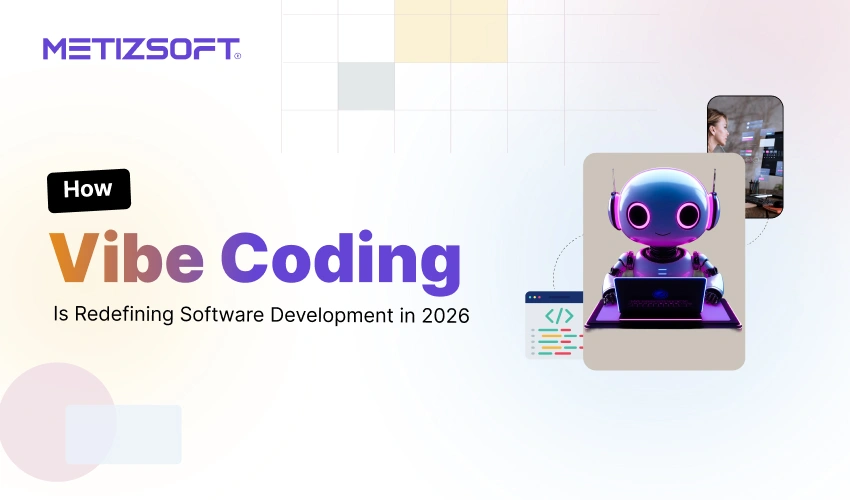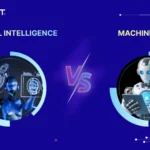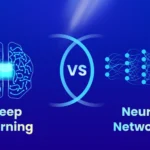
Table of Contents
Summary
Powered by AI advances, Vibe Coding refines software development by making it faster and collaborative for developers, project managers, and founders. Now, no more manual way of writing tons of lines of coding; just describe in simple language how you want your app to be and what it could do, and experience the vibe of the AI-assisted coding. This blog explains the detailed insights of Vibe coding for you to understand, adapt, and harness to meet your modern software development goals.
Introduction
That feeling when you finally realize that you can build an app not by manual coding but by simply describing your vision through conversation, and the code materializes, is incredible. Previously, it was a fantasy, but now with AI-powered Vibe Coding, it has become a reality in 2025 and is set to dominate for years to come! Vibe Coding is transforming the way software development is done. It’s the result of sheer frustration with those tedious debugging sessions and repetitive boilerplate code.
It was actually named and demonstrated by OpenAI research scientist Andrej Karpathy earlier this year!
As you read this blog, you will discover what vibe coding is and why many consider this AI-assisted coding method the next-generation programming for both outsourcing teams and in-house developers alike.
What is Vibe Coding?
Vibe coding is the process of teaching machines to sense and recognize human emotions, tone, and instructions in real time to write scalable code for software development. You convey the basic idea or “vibe” of your project, then let AI do all the technical heavy lifting. It combines elements from psychology, linguistics, and artificial intelligence to make digital interactions feel more human, empathetic, and natural.
This helps teams communicate naturally and achieve results faster, reducing barriers between technical and non-technical contributors.
Key Characteristics
- Natural Language Prompts: You describe your applications (the way you want to make them) in simple, conversational language.
- AI-Powered Code Generation: The smart and polished algorithm translates your descriptions into actual code.
- Iterative Improvements: Here, developers seamlessly communicate with AI, improving their understanding.
- Human-AI Collaboration: You stay in charge and leverage AI capabilities to create functional prototypes in hours instead of weeks or months.
This approach indicates that the time has come for developers, founders, and enterprises to shift from tedious coding practices to automation in software development to accelerate both prototyping and deployment.
Technologies Used for Vibe Coding
The Vibe Coding is built using several technological foundations that have all evolved together:
Advanced Language Model: Vibe Coding is based on highly advanced language models, the engines that make it all possible. These models are smarter, specialized, and trained systems that understand and generate complex code.
Beyond simple code suggestions, these models understand software structure, follow architectural patterns, reason through algorithms, and detect potential bugs or security risks before they even occur.
Specific Growing Environment: The starting AI coding tools were a bit difficult to use in traditional IDEs. But the new development platform, Vibe, is purpose-built for coding workflows.
- Cursor AI redefines the coding environment with natural language‑to‑code flow using its Composer tool.
- SuperWhisper enables voice‑to‑code functions, allowing developers to articulate logic aloud and watch real‑time code generation.
The main challenge now is to mix the old and the new. Many teams use hybrid setups where people maintain older, critical systems while new features are created through Vibe coding tools.
Benefits of Using Vibe Coding in 2026 Market Dynamics
- Speed and Efficiency: AI handles repetitive tasks and code optimization, significantly reducing development time.
- Lower Entry Barriers: Non‑technical founders can describe product ideas naturally and still produce functional prototypes.
- Reduced Errors: Context‑aware LLMs catch logical and syntax mistakes before deployment, improving reliability.
- Cost‑Effectiveness: Less manual coding means fewer working hours and a faster market launch. It’s a win-win situation, as your software development budget remains under control.
- Better Collaboration: Shared language between AI tools and human teams enhances communication across design, development, and product management.
As 2026 approaches, these benefits will make Vibe Coding a core feature for startups and tech companies looking to stay competitive in rapidly changing markets.
Vibe Coding Challenges and Limitations
Now that we know the advantages, which sound quite strong and attractive, let’s take a look at some of the disadvantages that you need to know to avoid problems.
- Accuracy Limitations: Despite advances, AI can misinterpret ambiguous signals or edge cases, highlighting the need for robust error handling.
- Security Risks: Automatically generated code may carry hidden vulnerabilities that require proper, multiple checks at times.
- Integration Complexity: You might need extra customization while mixing legacy environments with AI‑generated sections.
- Skill Gap: Your engineers must learn new ways to communicate with AI effectively. It’s a mindset shift from traditional to automated coding.
Yet these challenges are more transitional than permanent. With better training and refined models, most can be minimized through disciplined implementation and feedback.
Best Practices to Adapt Vibe Coding
You can’t simply get going with this AI-assisted coding method; you have to follow the practices below to make the most of Vibe Coding in your development workflow.
- Start Small: When you come across such new tools or coding methods, it’s always a good idea to experiment with low‑risk projects to understand prompt behavior before scaling.
- Fine‑Tune Prompts: Provide clear and structured instructions to drive better code outputs. You must invest in prompt engineering skills to master the art of AI conversation, or I could say instruction.
- Hybrid Approach: Let AI handle generation and refinement while you take care of the logic, security, and creative architecture.
- Continuous Feedback Loop: It’s a new concept, and no matter the automation level, you have to involve teams regularly to validate outcomes and optimize workflows.
- Stay Updated: Keep in line with new information, and explore new tool updates and guides as Vibe‑driven platforms evolve rapidly with the transformation.
Following up on these practices will definitely help you streamline the process. In case you feel like needing help, we suggest you approach a Vibe Coding Agency for professional consultation and guidance.
Future Trends and Predictions
- Emotionally Intelligent Code: AI will increasingly detect emotional tone and user intent to shape adaptive applications.
- Voice‑First Coding: Voice‑driven development sessions will replace typing for many collaborative workflows.
- Personalized AI Models: Tailored models trained on company‑specific codebases will handle domain‑relevant tasks autonomously.
- AI‑Native Teams: Software teams will restructure themselves to include prompt engineers and AI trainers as core roles.
- Cross‑Platform Continuity: Vibe Coding will tie mobile, web, and backend logic together through unified natural‑language development systems.
Getting Started With Vibe Coding
Stepping into the Vibe coding space is more about understanding AI behavior than mastering syntax. Although this is a relatively new idea and some issues still exist with code quality and ethics, the direction it is going looks very encouraging as AI systems continue to improve. If you are curious to explore the possibilities of AI-assisted coding for your upcoming project, you can hire Vibe Coders. They can easily integrate AI workflows into your current software development process.
Ready to leverage the evolving model of automation in software development with Vibe Coding? Partner with a reliable Vibe development service provider like Metizsoft as we have the right skilled and dedicated team who can help you move your creative idea from concepts to polished software through intuitive, conversational collaboration with AI.
AboutManthan Bhavsar
Related Posts
The Role of AI-Powered OCR in Form/Document Processing
Converting traditional or analog document formats to digital ones is crucial in document processing. As we navigate the...
How AI is Transforming Warehouse Management: Key Use Cases and Benefits
Table of Contents SummaryIntroductionAI in Warehouse Management: Key TakeawaysBenefits of AI in WarehousingAI Use Cases for...

